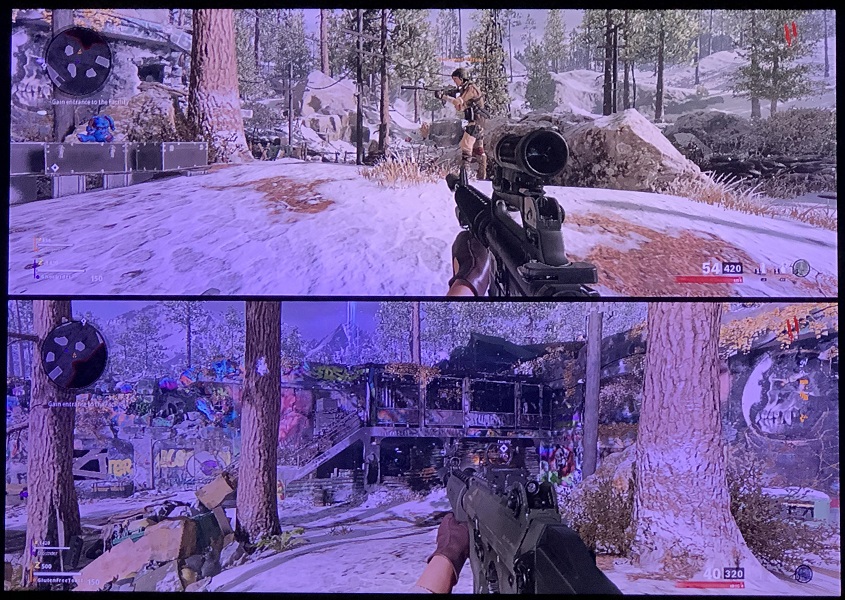

For collimation I use either a Cheshire or laser to position the secondary mirror (something that rarely needs adjustment) and a simple collimation cap for tweaking the primary. I’m purely a visual observer and mostly use scopes that are shade over f/4.
#Cold war zombies split screen ps4 how to
Take the time to learn how to use it well and you won’t need another. The important thing to remember is that you don’t have to get a bunch of tools - one chosen with care is all you need. Nearly as convenient and useful is the Cheshire eyepiece. If you do most of your collimation in the dark when you arrive at an observing site, this is the way to go. The Barlowed laser is also a good option, especially if you already have a Barlow lens in your eyepiece box. There are other tools and systems, but mostly they are either variations of those covered here, or devices that increase the complexity of the operation without a corresponding improvement in accuracy.įor most people, a simple collimation cap is fine.

With varying ease, all of them can help you accurately collimate scopes - even those with fast (under f/5) focal ratios. The five options described above cover those most commonly available and frequently used. Requires the centre of the primary mirror be marked. Worst features: Can be relatively expensive. This is my favourite method for collimating in the dark. Unlike a plain laser, the Barlowed version works very well and avoids the pitfalls of the former. You can also purchase Barlowed lasers from commercial sources such as Howie Glatter and Kendrick Astro Equipment. Essentially the setup consists of an ordinary laser collimator used in conjunction with a Barlow fitted with a target attached in front of the lens. As editor of the telescope-making department, I had the privilege of working with Nils to bring this to the pages of the magazine.

Most people heard about it the first time when Nils Olof Carlin’s article appeared in the January 2003 issue of Sky & Telescope (page 121). The Barlowed laser is the newest approach in the collimation game. The images show the telescope nearly collimated (top) and fully collimated (bottom). These views show the target for a Barlowed laser setup. Accuracy highly dependent on positioning of the secondary mirror.Įase of use: Relatively difficult to use successfully. Accuracy dependent on mechanical alignment of the laser within its housing and how the device seats in the focuser. Requires centre of primary to be marked.Īccuracy: Potentially accurate if used correctly. Worst features: Can lead to miscollimation. Useful for adjusting the secondary mirror. I don’t recommend it for adjusting the primary, however.īest features: Can be used in the dark. That said, I have a laser collimator and find it a useful tool for adjusting the tilt of the secondary mirror. In other words, if your scope’s secondary mirror isn’t set correctly, you can actually achieve a “pass” by putting your primary mirror out of alignment - a situation that can have disastrous consequences when it comes to image quality. Why? The Achilles heel of the laser collimator is that its accuracy depends on how carefully you’ve adjusted your scope’s secondary mirror - a procedure that is far more difficult than it is important to image quality. Unfortunately, it’s been my experience that beginners all too often end up de-collimating their scopes when using one of these.

Laser collimators have been around for many years now and seem to be especially attractive to those who equate lasers with precision. Experience will make the method more reliable and effective.Ī laser collimator tool for 1¼” focusers. It’s also not the best way to ensure the secondary mirror is correctly placed.Įase of use: For the highest accuracy you’ll need a night of good, steady seeing. It’s also usually more time consuming than other methods and requires a star (or point-source light). Worst features: The method takes some experience and isn’t the best choice for absolute beginners. No centre dot is needed on the primary mirror. If it looks right in the star test, it is right.īest features: You can do it without spending a single dollar. Regardless of what other collimation method you use, the star test is the final arbiter of optical alignment. The test becomes progressively more sensitive the nearer you get to focus. It’s called the “star test.” The detailed ins and outs of this method are beyond the scope of this article, but essentially you centre a bright star in the eyepiece, throw it out of focus, and note where the shadow of the secondary mirror is positioned within the expanded disk of light. Yes, it is possible to collimate your reflector without any tools. This pair of star-test simulations shows an uncollmated scope (top) and one that’s properly aligned (bottom).


 0 kommentar(er)
0 kommentar(er)
